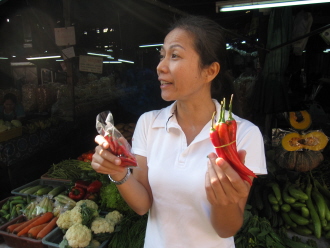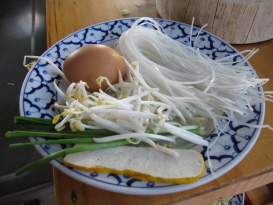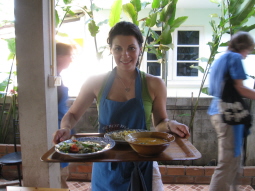By Alona Cherkassky
“Chop! Mix! Stir! Harder! Mind your garlic! And please, don’t set your kitchen at home on fire!”
Do you know that garlic can be cooked with skin or without?  But cooking it with skin prevents it from turning bitter. Eggs don’t have to be refrigerated for up to four weeks. Pad Thai is cooked with Palm sugar. Pink eggs come from flamingos. Chinese bok choi has little yellow flowers and sticky rice is best when soaked overnight. But cooking it with skin prevents it from turning bitter. Eggs don’t have to be refrigerated for up to four weeks. Pad Thai is cooked with Palm sugar. Pink eggs come from flamingos. Chinese bok choi has little yellow flowers and sticky rice is best when soaked overnight.
These are just some of the things I try to remember during the early morning market tour before the Thai cooking class, one of the more popular things to do here in the Northern Thai town of Chiang Mai.
Boom, our cooking instructor and owner of the Best Thai Cookery School, took us on an hour-long tour, poking fun at our Western habits of eating, and walking us through the remarkable details of the different types of rice, chili, vegetables, and mixtures that make the Thai cuisine intoxicating. Everything is always prepared fresh. The only canned products are coconut cream. The rest--noodles, eggs, vegetables--are purchased on the day locals make the dish. For a traditional dinner, Thais never just make one dish. The more people in the party, the more dishes are made, so that everyone can share.
At the school itself, students typically cook in a large kitchen that comes equipped with individual stations that include tiny stoves, a few pots, spatulas, spoons and a big chopping knife on a wooden block. Assistants bring in chopped up ingredients, and Perm (the main chef) mixes the  sauces but not before instructing us, and maybe being a bit patronizing, on the precise measurements of palm sugar, chili, salt, pepper, and about 100 more ingredients. sauces but not before instructing us, and maybe being a bit patronizing, on the precise measurements of palm sugar, chili, salt, pepper, and about 100 more ingredients.
I have never been a big fan of curry, but here, with Perm’s careful observation, it becomes almost food of the Gods. My red curry with chicken takes longer than other dishes to prepare, and the instructors don’t mince words when they check out my creation. Perm says curry is like love, and takes time. Here’s the secret: When first mixing the curry with spices, stir constantly until the mixture becomes oily. Then add coconut milk. After bringing to boil, add chicken and other carefully selected ingredients including pineapple. Let the curry sit for a bit before eating. When ready to eat, warm it up, and mix it with white rice. Go to heaven.
Next we make Pad Thai, which is prepared with the right combination of sauces and palm sugar. If one can memorize the sauce and spice combination, Pad Thai takes about 3 minutes to make. Here in Thailand, the “loving” way of preparing it is to wrap it in an omelet, rather than by scrambling the egg. I can’t seem to evenly spread the egg around the wok so Boom loses patience with me and tells me to scramble.  Once the noodles and tofu are ready, add the egg, and a few minutes later lunch is served either on a plate or in a banana leaf, a good way of wrapping it “to go.” Once the noodles and tofu are ready, add the egg, and a few minutes later lunch is served either on a plate or in a banana leaf, a good way of wrapping it “to go.”
When feasting on the dishes I just made, I feel a remarkable sense of achievement. My curry, vegetables and noodles taste completely authentic, same as at any restaurant or food stall. I am strangely not hungry after cooking all day so I savor my food slowly. What’s the rush here in Thailand anyway?
Taking a cooking course is a remarkably popular activity here in Chiang Mai and can be set up through any travel agency. Typically, prices vary between 900 and 1000 Baht (about $33 US Dollars). The class is an all-day affair, lasting about 6 hours.
Photo Credits: Photos by Alona Cherkassky, with the exception of the one on the lower right, which is Alona herself.
|
|
|

